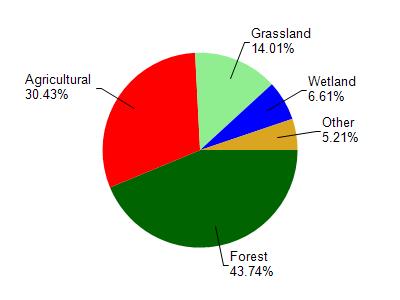Portage
No
No
Yes
Fish and Aquatic Life
Overview
Spring Lake is a clear, hard water lake located five miles southwest of Amherst. One inlet, Mack Creek, and numerous springs provide a good supply of cold vater to the lake. Mack Creek and Spring Creek, the outlet, are both important trout streams. Large portions of the lake bottom are covered with marl which appears to have been mined at one tire. Sand, silt, and rubble compose the remainder of the littoral bottom materials. The lake is managed for both warm and cold water species. Brook, brown, and rainbow trout make up the cold water fishery. Perch, largemouth bass, bluegills, rock bass, pumpkinseed, white sucker, and forage fish are the warm water species present. The most significant wildlife use of this lake is as a "duck factory." Several broods of mallard and teal were observed. Migratory waterfowl also use the lake. Developments are limited to eight dwellings, several of which are trailer houses. Two public access sites, one on the north and another on the south side, both with gravel boat launching ramps are available. Neither offers much parking space. No picnicking or other recreation facilities are present.
Source: 1972, Surface Water Resources of Portage County Spring Lake, T22N, R10E, Section 7, Surface Acres-36.5, S.D.F.- 2.61, Maximum Depth-42 feet.
Date 1972
Author Aquatic Biologist
Impaired Waters
Spring Lake (WBIC 267200) was placed on the impaired waters list for total phosphorus in 2016. The 2018 assessments showed continued impairment by phosphorus; new total phosphorus sample data overwhelmingly exceeded the 2018 WisCALM listing thresholds for the Recreation use and Fish and Aquatic Life use. Based on the most updated information, no change in the existing impaired waters listing was needed.
Date 2017
Author Ashley Beranek
Impaired Waters
This water was assessed during the 2016 listing cycle; total phosphorus sample data exceed 2016 WisCALM listing thresholds for the Recreation use and Fish and Aquatic Life use, however chlorophyll data do not exceed REC or FAL thresholds.
Date 2015
Author Aaron Larson
Condition
Wisconsin has over 84,000 miles of streams, 15,000 lakes and milllions of acres of wetlands. Assessing the condition of this vast amount of water is challenging. The state's water monitoring program uses a media-based, cross-program approach to analyze water condition. An updated monitoring strategy (2015-2020) is now available. Compliance with Clean Water Act fishable, swimmable standards are located in the Executive Summary of Water Condition in 2018. See also the 'monitoring and projects' tab.
Reports
Management Goals
Wisconsin's Water Quality Standards provide qualitative and quantitative goals for waters that are protective of Fishable, Swimmable conditions [Learn more]. Waters that do not meet water quality standards are considered impaired and restoration actions are planned and carried out until the water is once again fishable and swimmable
Management goals can include creation or implementation of a Total Maximum Daily Load analysis, a Nine Key Element Plan, or other restoration work, education and outreach and more. If specific recommendations exist for this water, they will be displayed below online.
Monitoring
Monitoring the condition of a river, stream, or lake includes gathering physical, chemical, biological, and habitat data. Comprehensive studies often gather all these parameters in great detail, while lighter assessment events will involve sampling physical, chemical and biological data such as macroinvertebrates. Aquatic macroinvertebrates and fish communities integrate watershed or catchment condition, providing great insight into overall ecosystem health. Chemical and habitat parameters tell researchers more about human induced problems including contaminated runoff, point source dischargers, or habitat issues that foster or limit the potential of aquatic communities to thrive in a given area. Wisconsin's Water Monitoring Strategy was recenty updated.
Grants and Management Projects
Monitoring Projects
| WBIC | Official Waterbody Name | Station ID | Station Name | Earliest Fieldwork Date | Latest Fieldwork Date | View Station | View Data |
|---|
| 267200 | Spring Lake | 10005118 | Spring Lake | 7/27/1999 | 3/12/2024 | Map | Data |
| 267200 | Spring Lake | 503141 | Spring Lake - Deepest Spot | 4/7/1994 | 9/24/2025 | Map | Data |
| 267200 | Spring Lake | 10017563 | Spring Lake -- Access | 6/25/2009 | 6/20/2024 | Map | Data |
|

Watershed Characteristics
Spring Lake is located in the Waupaca River watershed which is 290.77 mi². Land use in the watershed is primarily forest (43.70%), agricultural (30.40%) and a mix of grassland (14%) and other uses (11.80%). This watershed has 231.34 stream miles, 2,456.10 lake acres and 14,124.68 wetland acres.
Nonpoint Source Characteristics
This watershed is ranked Medium for runoff impacts on streams, Not Ranked for runoff impacts on lakes and High for runoff impacts on groundwater and therefore has an overall rank of High. This value can be used in ranking the watershed or individual waterbodies for grant funding under state and county programs.However, all waters are affected by diffuse pollutant sources regardless of initial water quality. Applications for specific runoff projects under state or county grant programs may be pursued. For more information, go to surface water program grants.